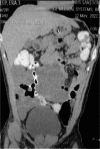Intra-abdominal Inflammatory Myofibroblastic Tumour (IMFT)-Uncommon Entity
- PMID: 38817997
- PMCID: PMC11133245
- DOI: 10.1007/s13193-023-01869-8
Intra-abdominal Inflammatory Myofibroblastic Tumour (IMFT)-Uncommon Entity
Abstract
IMFT (inflammatory myofibroblastic tumour) is an uncommon tumour predominantly affecting the lungs and mediastinum. Most of the published literature supports that it affects children and young individuals. IMFT involving the gastrointestinal tract is rare. We report a case of multifocal IMFT affecting the GI tract which was managed with gross total excision followed by chemotherapy. Surgical resection remains the treatment of choice. The role of chemotherapy and radiation therapy remains limited. The aetiology of these tumours remains unclear and is mostly ALK-positive that could be targeted. Local recurrences are common and hence require close follow-up. The risk of recurrences and metastasis is increased in cases with TP53 positivity, aneuploidy and recurrent lesions.
Keywords: ALK Rearrangement; GI tract; IMFT; Recurrence.
© The Author(s), under exclusive licence to Indian Association of Surgical Oncology 2023. Springer Nature or its licensor (e.g. a society or other partner) holds exclusive rights to this article under a publishing agreement with the author(s) or other rightsholder(s); author self-archiving of the accepted manuscript version of this article is solely governed by the terms of such publishing agreement and applicable law.
Conflict of interest statement
Conflict of InterestThe authors declare no competing interests.
Figures




Similar articles
-
Anaplastic lymphoma kinase (ALK 1) staining and molecular analysis in inflammatory myofibroblastic tumours of the bladder: a preliminary clinicopathological study of nine cases and review of the literature.Mod Pathol. 2004 Jul;17(7):765-71. doi: 10.1038/modpathol.3800078. Mod Pathol. 2004. PMID: 15105807 Review.
-
Inflammatory myofibroblastic tumor presenting as ileocecal intussusception-A case report.Int J Surg Case Rep. 2016;24:146-9. doi: 10.1016/j.ijscr.2016.05.027. Epub 2016 May 19. Int J Surg Case Rep. 2016. PMID: 27262346 Free PMC article.
-
Crizotinib in patients with advanced, inoperable inflammatory myofibroblastic tumours with and without anaplastic lymphoma kinase gene alterations (European Organisation for Research and Treatment of Cancer 90101 CREATE): a multicentre, single-drug, prospective, non-randomised phase 2 trial.Lancet Respir Med. 2018 Jun;6(6):431-441. doi: 10.1016/S2213-2600(18)30116-4. Epub 2018 Apr 15. Lancet Respir Med. 2018. PMID: 29669701 Clinical Trial.
-
Colonic inflammatory myofibroblastic tumours: an institutional review.Colorectal Dis. 2013 May;15(5):e239-43. doi: 10.1111/codi.12149. Colorectal Dis. 2013. PMID: 23350604
-
Inflammatory myofibroblastic disease of right petrous apex: A rare case with review of literature.J Cancer Res Ther. 2024 Apr 1;20(3):1077-1080. doi: 10.4103/jcrt.JCRT_1451_20. Epub 2024 Jan 22. J Cancer Res Ther. 2024. PMID: 38261452 Review.
References
-
- Ntloko S, Gounden A, Naidoo M, Madiba TE, Sing Y, Hadley GP. Intestinal inflammatory myofibroblastic tumour. S Afr J Surg. 2011;49(4):190–193. - PubMed
Publication types
LinkOut - more resources
Full Text Sources
Research Materials
Miscellaneous
